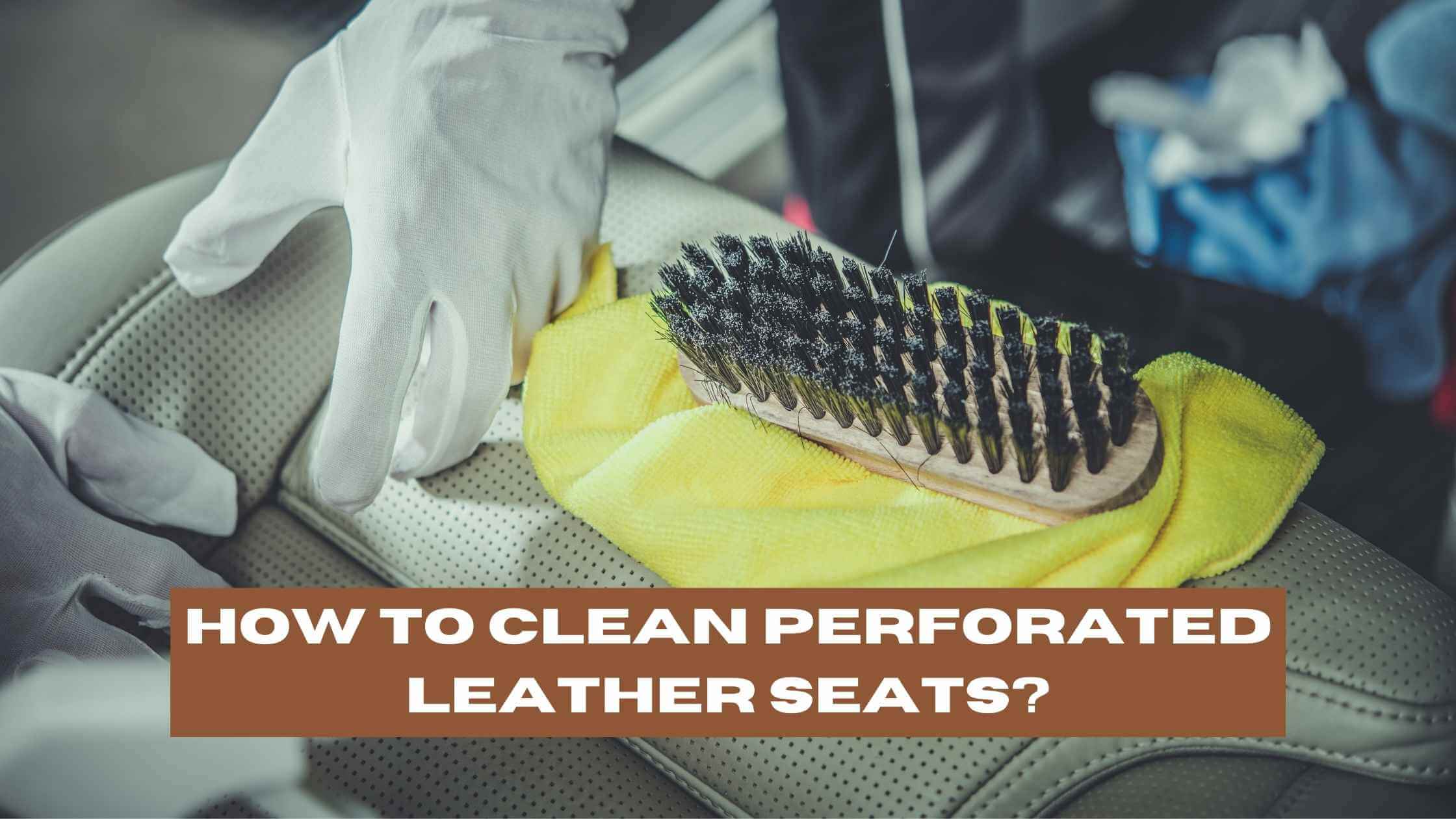If you have perforated leather seats, you might be a little lost on just how you should be caring for them without missing any spots! Here’s how to clean perforated leather seats and tips to help you tackle this common issue.
Cleaning your perforated leather seats may take extra work, but it won’t be complex. After you follow the usual steps to cleaning your leather seats, you’ll want to add a few extra specific steps to cleaning the holes. The best methods for cleaning out the holes specifically in your seats include using an air compressor, putting a steam cleaner to work, or using a toothpick!
Read on for more detail on these methods and how to integrate them into your regular cleaning routine.
Can you use leather cleaner on perforated seats?
You can safely use any leather cleaner on your perforated seats. The leather seats have been carefully designed to hold up to traditional leather care products, so you won’t need to worry about the cleanser ruining the perforation holes.
That being said, you’ll still want to learn how to clean out the holes themselves since they need to be left clear to promote the breathability that you’re looking for in the first place. We’ll cover that next!
How to clean perforated leather seats step by step
If you’re looking for a step-by-step process of how to clean your leather seats, here are the different points:
- Remove debris and surface dirt
- Use a leather cleanser to remove more dirt
- Focus on the holes using your tool of choice
- Sprinkle some baking soda onto your seats
- Swipe off
- Apply conditioner as normal
- Do a final hole check
1. Remove debris and surface dirt
Using a vacuum and/or an air compressor, remove as much debris and surface dirt as possible from your leather car seats. This will make the rest of the process easier and ensure that you don’t accidentally push grime into the perforation holes.
2. Use a leather cleanser to remove more dirt
With a soft cloth and mild leather cleanser, remove more dirt from every part of the leather seat. This should also alert you if you missed a spot with the vacuum. If so, you’ll need to pay extra attention to those areas, or just grab that vacuum or air compressor again and give it another go!
3. Focus on the holes using your tool of choice
Once the leather is clean, you’ll want to focus on the holes. Use your favorite tool or a combination of them, and start picking debris out of the holes. You only have to use these tools on the holes that seem clogged. You could hypothetically do every single hole, but it would take forever. However, no rule says you can’t, either…
A vacuum is a great tool for cleaning out dust or sand stuck in holes. This is great when cleaning car seats after a trip to the beach, for example.
4. Sprinkle some baking soda onto your seats
If you are concerned about lingering smells, sprinkle some baking soda on it and let it sit for 5-10 minutes. This will absorb any leftover moisture, too, which is good for ensuring that all the cleanser and water are totally dried.
5. Swipe off
Swipe or sweep off any baking soda using a dry cloth or gentle brush. Since it is absorbent, you don’t want to leave it on too long as it could dehydrate your leather!
6. Apply conditioner as normal
Apply your leather conditioner in an even, thorough coat. You don’t need to be particular about skipping the perforation holes. Apply it evenly and ensure you get every inch of your seat.
7. Do a final hole check
As a final detail, you’ll want to check your perforation holes. For example, if any seem blocked from the conditioner, gently pick them free with a toothpick to clear the holes. You don’t necessarily have to do this, but it is a good idea to help the perforation holes do their job.
How to steam clean perforated leather car seats properly
If you’re curious about just how to toe the line when it comes to using a steam cleaner but responsibly for your leather’s sake, here are some steps to help you out:
- Be familiar with the different settings of your steamer
- Work with a low setting
- Keep your sessions short
- Blot with a cloth each time
Since leather and water don’t always get along well, understanding how to work responsibly with a steam cleaner is essential!
Fun Fact: Did you know that steam cleaning can also offer sanitizing on top of cleansing? It’s an excellent product for keeping your leather items bacteria-free.
How to remove a bad odor from perforated leather seats
If you notice any odors that are bothering you as your clean, give it a quick clean with equal parts water and vinegar before you use your leather cleanser. After it’s on the leather for 5 minutes, you can wipe it off with clean water. Sometimes the vinegar can linger as a scent, so don’t leave it on too long!
Fun Fact: Did you know that using a vinegar mix is one of the best ways to clean your leather naturally?
How do you clean perforated leather seats after a spill?
This section is a must-read if you’re looking for tips on cleaning perforated leather seats after a direct spill. The tips to follow include:
- Soak up as much of the spill as you can with towels and tags
- Apply mild soap with warm water to the leather seats
- Rinse with plain water
- Blot dry thoroughly
- Apply some baking soda with a cloth preventatively
- Sweep off after 15 minutes
- Clean and condition as normal
The baking soda is going to help you both clean and absorb any kind of potential odors from the spill. You can also use this method for vomit, milk, and chocolate, which tend to be odor-rich!
The best tools to clean perforated leather seats
While “best” can be subjective, I’ve put together a list of products that I would recommend to anyone who wants to clean leather seats thoroughly. The top ones for your approach to hole cleaning, in particular:
- A steamer
- Durable toothpicks
- A fine attachment for your vacuum
A steamer
When looking specifically for a leather steamer, it’s essential to get the right kind of steamer. You can’t just use any type of steamer on leather, as you might be able to guess. You’ll want to have an upholstery cleaner or, at least, a hard-surface steamer. A facial or clothing steamer will be too strong for your leather and damage it.
Durable toothpicks
Toothpicks are a dime a dozen, so they’re simple to use. For the best results, I recommend plastic ones. Wood can splinter off and create fragments that are harder to get out of perforation holes! Plastic ones can be sharp, so be careful with pressure!
A fine attachment for your vacuum
Every vacuum will be different, of course, but some will come with these ultra-fine attachments for vacuums. You can get a brand-specific one or consider a multi-purpose attachment if yours doesn’t. These are more commonly known as flexible crevice tools.
What is the best cleaner for perforated leather seats?
This will also be a personal choice, but I’d have to say that my two go-to options are a steamer and baking soda. Steam is excellent for removing marks and grime (especially loosening debris in the holes). Baking soda is the best for odor removal, and easy to simply brush off leather after it’s done.
Tip: Try to clean your perforated seas about twice a year to help make the hole cleaning itself easier.
You don’t need a different cleaning routine when effectively cleaning perforated leather seats. However, you will want to take a detailed approach to those perforations.
Your best tools and products include an air compressor, a purpose-designed steamer, and toothpicks! Proper cleaning helps keep your seats fresh and your leather in its best shape.
If you know someone who needs some help with their perforated leather car seats, share this with them to help them get done with their cleaning easily and quickly without putting their leather at risk.

